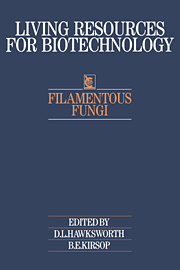Book contents
- Frontmatter
- Contents
- Contributors
- Series introduction
- Preface
- Acknowledgements
- 1 Resource centres
- 2 Information resources
- 3 Administration and safety
- 4 Culture and preservation
- 5 Identification
- 6 Patent protection for biotechnological inventions
- 7 Culture collection services
- 8 Organisation of resource centres
- Appendix: Media
- References
- Index
8 - Organisation of resource centres
Published online by Cambridge University Press: 04 August 2010
- Frontmatter
- Contents
- Contributors
- Series introduction
- Preface
- Acknowledgements
- 1 Resource centres
- 2 Information resources
- 3 Administration and safety
- 4 Culture and preservation
- 5 Identification
- 6 Patent protection for biotechnological inventions
- 7 Culture collection services
- 8 Organisation of resource centres
- Appendix: Media
- References
- Index
Summary
Introduction
Individual resource and information centres provide valuable services to biotechnology, but their role can be substantially enhanced if their activities are effectively co-ordinated. This has been recognised in the past, and a number of committees, federations and networks have been set up for this purpose at the national, regional and international levels. Although the origins and composition of existing organisations differ and their geographical locations are widespread, their common purpose is to support and develop the activities of resource and information centres for the benefit of microbiology.
International organisation
World Federation for Culture Collections
There are fewer difficulties in setting up national and regional co-ordinating mechanisms than international systems, and yet one of the first developments in this area was the formation of the World Federation for Culture Collections (WFCC). In 1962 at a Conference on Culture Collections held in Canada it was recommended that the International Association of Microbiological Societies (IAMS) set up a Section on Culture Collections. The Section was established in 1963. Five years later, at an International Conference on Culture Collections in Tokyo, the formation of the WFCC was proposed and an ad hoc committee, together with the Section on Culture Collections, drew up statutes which were agreed at a congress in 1970. Following the conversion of the IAMS to Union status, the WFCC is now a federation of the International Union of Microbiological Societies (IUMS) and an interdisciplinary Commission within the International Union of Biological Sciences (IUBS).
The principal objective of the WFCC is to establish effective liaison between persons and organisations concerned with culture collections and the users of the collections both in the developed and developing regions of the world.
- Type
- Chapter
- Information
- Filamentous Fungi , pp. 173 - 187Publisher: Cambridge University PressPrint publication year: 1988
- 1
- Cited by

